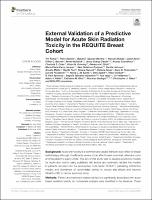| dc.contributor | Vall d'Hebron Barcelona Hospital Campus |
| dc.contributor.author | Rattay, Tim |
| dc.contributor.author | Seibold, Petra |
| dc.contributor.author | Aguado-Barrera, Miguel E. |
| dc.contributor.author | Barnett, Gillian C. |
| dc.contributor.author | Gutierrez Enriquez, Sara |
| dc.contributor.author | Valdagni, Riccardo |
| dc.contributor.author | Reyes López, Victoria |
| dc.contributor.author | Azria, David |
| dc.contributor.author | Altabas González, Manuel |
| dc.date.accessioned | 2021-09-09T10:54:24Z |
| dc.date.available | 2021-09-09T10:54:24Z |
| dc.date.issued | 2020-10-30 |
| dc.identifier.citation | Rattay T, Seibold P, Aguado-Barrera ME, Altabas M, Azria D, Barnett GC, et al. External Validation of a Predictive Model for Acute Skin Radiation Toxicity in the REQUITE Breast Cohort. Front Oncol. 2020 Oct 30;10:575909. |
| dc.identifier.issn | 2234-943X |
| dc.identifier.uri | https://hdl.handle.net/11351/6287 |
| dc.description | Breast cancer: Prediction model; Radiotherapy |
| dc.description.abstract | Background: Acute skin toxicity is a common and usually transient side-effect of breast radiotherapy although, if sufficiently severe, it can affect breast cosmesis, aftercare costs and the patient's quality-of-life. The aim of this study was to develop predictive models for acute skin toxicity using published risk factors and externally validate the models in patients recruited into the prospective multi-center REQUITE (validating pREdictive models and biomarkers of radiotherapy toxicity to reduce side-effects and improve QUalITy of lifE in cancer survivors) study.
Methods: Patient and treatment-related risk factors significantly associated with acute breast radiation toxicity on multivariate analysis were identified in the literature. These predictors were used to develop risk models for acute erythema and acute desquamation (skin loss) in three Radiogenomics Consortium cohorts of patients treated by breast-conserving surgery and whole breast external beam radiotherapy (n = 2,031). The models were externally validated in the REQUITE breast cancer cohort (n = 2,057).
Results: The final risk model for acute erythema included BMI, breast size, hypo-fractionation, boost, tamoxifen use and smoking status. This model was validated in REQUITE with moderate discrimination (AUC 0.65), calibration and agreement between predicted and observed toxicity (Brier score 0.17). The risk model for acute desquamation, excluding the predictor tamoxifen use, failed to validate in the REQUITE cohort.
Conclusions: While most published prediction research in the field has focused on model development, this study reports successful external validation of a predictive model using clinical risk factors for acute erythema following radiotherapy after breast-conserving surgery. This model retained discriminatory power but will benefit from further re-calibration. A similar model to predict acute desquamation failed to validate in the REQUITE cohort. Future improvements and more accurate predictions are expected through the addition of genetic markers and application of other modeling and machine learning techniques. |
| dc.language.iso | eng |
| dc.publisher | Frontiers Media |
| dc.relation.ispartofseries | Frontiers in Oncology;10 |
| dc.rights | Attribution 4.0 International |
| dc.rights.uri | http://creativecommons.org/licenses/by/4.0/ |
| dc.source | Scientia |
| dc.subject | Mama - Càncer - Radioteràpia |
| dc.subject | Pell - Efecte de la radiació |
| dc.subject.mesh | Breast Neoplasms |
| dc.subject.mesh | /radiotherapy |
| dc.subject.mesh | Skin |
| dc.subject.mesh | /radiation effects |
| dc.title | External Validation of a Predictive Model for Acute Skin Radiation Toxicity in the REQUITE Breast Cohort |
| dc.type | info:eu-repo/semantics/article |
| dc.identifier.doi | 10.3389/fonc.2020.575909 |
| dc.subject.decs | neoplasias de la mama |
| dc.subject.decs | /radioterapia |
| dc.subject.decs | piel |
| dc.subject.decs | /efectos de la radiación |
| dc.relation.publishversion | https://www.frontiersin.org/articles/10.3389/fonc.2020.575909/full |
| dc.type.version | info:eu-repo/semantics/publishedVersion |
| dc.audience | Professionals |
| dc.contributor.organismes | Institut Català de la Salut |
| dc.contributor.authoraffiliation | [Rattay T] Cancer Research Centre, University of Leicester, Leicester, United Kingdom. [Seibold P] Division of Cancer Epidemiology, German Cancer Research Center (DKFZ), Heidelberg, Germany. [Aguado-Barrera ME] Fundación Pública Galega Medicina Xenómica, Santiago de Compostela, Spain. Instituto de Investigación Sanitaria de Santiago de Compostela, Santiago de Compostela, Spain. [Altabas M, Reyes V] Servei d’Oncologia Radioteràpica, Vall d’Hebron Hospital Universitari, Barcelona, Spain. [Azria D] Fédération Universitaire d’Oncologie Radiothérapie d’Occitanie Méditérranée, Département d’Oncologie Radiothérapie, ICM Montpellier, INSERM U1194 IRCM, University of Montpellier, Montpellier, France. [Barnett GC] Department of Oncology, University of Cambridge, Cambridge, United Kingdom. [Gutiérrez-Enríquez S] Hereditary Cancer Genetics Group, Vall d’Hebron Institute of Oncology (VHIO), Barcelona, Spain. Vall d’Hebron Hospital Universitari, Barcelona, Spain. [Valdagni R] Hereditary Cancer Genetics Group, Vall d’Hebron Institute of Oncology (VHIO), Barcelona, Spain. Vall d’Hebron Hospital Universitari, Barcelona, Spain. Department of Radiation Oncology 1, Fondazione IRCCS Istituto Nazionale dei Tumori, Milan, Italy. Department of Hematology and Hemato-Oncology, Università degli Studi di Milano, Milan, Italy |
| dc.identifier.pmid | 33216838 |
| dc.identifier.wos | 000589058600001 |
| dc.relation.projectid | info:eu-repo/grantAgreement/EC/FP7/601826 |
| dc.rights.accessrights | info:eu-repo/semantics/openAccess |

